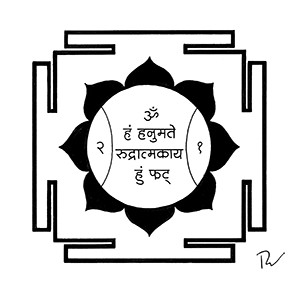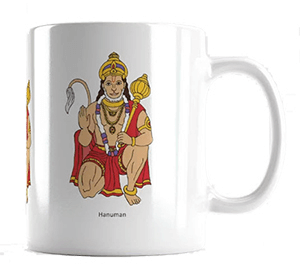
Hanuman Yantra Complete Guide
The Hanuman yantra is a symbolic representation of the Hindu monkey-god and his primary mantra. Hanuman is the hero of epics and stories in Hinduism, Jainism, and Buddhism. Hanuman is the ardent devotee of Lord Rama. He is a central figure in the epic Hindu poem Ramayana. Learn more about this unique yantra and its benefits!
Share this page with a friend!
Who Is Hanuman?
Hanuman is the patron of martial arts, wrestling, and acrobatics. He is also the patron of meditation and scholarship. Some interpretations of the name “Hanuman” are the Sanskrit words “han” meaning killed or destroyed and “maana” meaning pride. With this interpretation, Hanuman would mean “one whose pride was destroyed.”
Click to see this print in our gift store!
Powers of Hanuman
Hanuman has many superhuman powers. These include the following:
- cannot be killed with any weapon in war
- power to induce fear in enemies
- power to destroy fear in friends
- cannot be harmed by the Vajra weapon (lightning)
- cannot be drowned (protection from water)
- cannot be harmed by fire (Agni)
- is not attracted to women
- can make himself as small or as large as he wants
- cannot be killed (longevity and immortal life)
- will always be happy and content
Hanuman Yantra Symbolism
The basic form of the Hanuman yantra is a square with four gates. This is a standard form for most yantras. The square represents the four cardinal directions. A square also symbolizes the foundation or base of the material world. The numerical equivalent, of course, is the number four. The square connects to the earth element in the Vedic tradition.
The Four Gates
On each side of the yantra are gates that open up to invite the viewer into the center of the yantra. The gates represent a passage between the heaven world and the plane of material existence. They also symbolize the opening between the inner and outer realms of the individual. The gates protect the center from disintegrating or negative forces.
The Circle
Inside of the square and gates is a circle and a lotus flower with eight petals. The circle symbolizes infinite space (the element akasha) and expansiveness. The circle also represents the cycles of nature at all levels from the atom to astronomy. The central quest of spirituality is to experience the Oneness of these realms.
Inner Circle of 8 Lotus Petals
The inner ring of eight lotus petals each have their own symbolism. The petals represent siddhis or yogic powers. Specific deities embody each of these powers. These are sometimes viewed as specific human activities: speech, motion, grasping, revulsion, enjoyment, attraction, equanimity and excretion.
Meaning of Inner Circle Petals
Mastering the qualities of each petal through meditation, self-observation and individual effort can grant both worldly and spiritual success. The specific meaning of the petals can be outlined as follows:
ANIMA: This word means smallness or vulnerability. The siddhi or power conveyed is closely related to honesty with yourself and others. This is the ability to connect to yourself internally.
LAGHIMA: Laghima means bigness in the sense of taking the maximum amount of responsibility in your own life. This also conveys a connection to the largest self or the universe.
GARIMA: Garmina means heaviness, grounding, an anchor or a weight. This is a positive sense of being rooted to the earth, being unmoved by circumstances and sticking to your purpose.
MAHIMA: Mahima means creativity. This yogic power is a direct connection to a free flow of ideas and the resulting accomplishments.
EASATVA: Easatva means godliness and purity. This is the power of courage and confidence that comes from knowing you are pursuing your own highest calling in wisdom and love.
VASATVA: Vasatva means subjugation, bringing under control and conquering the self. This is the ability to overcome obstacles in life versus utilizing violence or overcoming others.
PRAAKAMYA: Praakamya means fulfilling the objective. This involves creating a strategy and a sense of conviction so strong that you feel that all that is necessary has already happened.
Lotus Symbol and the Heart
The lotus is also a symbol of the heart, especially the inner or secret chamber of the heart. Hanuman is one of the main Hindu deities associated with the heart chakra. He is often depicted showing with his hands opening up his chest to show the fire of his heart.
Sanskrit Mantra in the Hanuman Yantra
The Hanuman yantra contains Sanskrit symbols and words. The letters and sound-syllables from Sanskrit traced on a yantra represent different fundamental thoughtforms. In the case of the Hanuman yantra, the inscription is a specific mantra: “OM HUM Hanumate Rudratmakaya Hoom Phat.” A word by word translation is given below.
OM: At the top of the Hanuman yantra is the symbol for OM. OM is associated with the universe in all of its manifestations. Some consider OM to be the hum of creation. Learn more in the article One Word Mantras.
HUM: In the first line of symbols, the symbol to the far left stands for HUM (see image above). HUM (huhm) is a fire mantra that can help to kindle the consciousness. This is an etheric fire connected to lightning, pranic fire, and the breath. This lightning can also be used for protection. HUM is sometimes referred to as the “seed syllable of wrath” or righteous anger.
HANUMATE: Next in the first full line in the Hanuman yantra is the Sanskrit word “Hanumate,” a reference to Hanuman’s great physical strength, stamina and power.
RUDRATMAKAYA: The third line is the word “Rudratmakaya.” This word means the alleviation of suffering. “Rudra” is a name for Shiva, the cleansing or destructive force in the universe. Rudra mantras are said to remove fear and relieve the individual of all states of discomfort.
HOOM: The last line in the Hanuman yantra is “Hoom Phat.” These words are a type of mantra weapon. This simply means that these are very strong energies to remove negativity. Hoom is often related to force goddesses like Kali and Chandi. In this case, the word is connected to Hanuman.
PHAT: The final word “phat” means without a doubt. This word serves as an affirmation of the mantra. As a whole, this is a strong mantra that can shift situations suddenly.
Benefits of the Hanuman Yantra
The Hanuman yantra is a good choice for focusing on supporting your immune system, increasing your productivity and helping with effective communication skills. Hanuman is known for fierce loyalty and unfailing energy. Hanuman is often appealed to for solutions in seemingly impossible circumstances.
Strength of Mind and Body
The Hanuman yantra is associated with strength of mind as well as body. This is the kind of strength needed to confront and triumph over the hurdles in life. The energy carried by Hanuman as a personification of universal consciousness encourages straight-forward communication and clear thinking. The combination of Hanuman’s mantra and yantra helps to center the heart to overcome difficult situations.
Hanuman and the Planet Saturn
Some sources say Hanuman protects against malefic influences from a challenging placement of Saturn in your astrological chart. Other sources say the same thing about an ill-placed Mars. Examples of mantras for Mars and Saturn are included in the article Astrology Mantras.
Hanuman Yantra and Astrology
As noted above, the Hanuman yantra and mantra can be used to alleviate difficult astrological configurations. Hanuman is associated with the mastery of the planets Mars and Saturn and their energies. There are mantras to mitigate the effects of Mars and Saturn or to accelerate positive aspects as found in an individual’s astrological chart.
Mars in Vedic Astrology
Mars is called Mangala in Vedic astrology. Managala is connected to anger but also to the drive necessary to succeed in life in both material and spiritual pursuits. Saturn is the bearer of karma, which can bring both good and bad effects depending on decisions that have been made at earlier points in life. Listen to mantra videos for Mars and Saturn. Learn more about Astrology Mantras.
Watch nearly 400 videos on the Vocal Medicine Channel!
Hanuman Mantra
Hanuman is a joyful figure, blessed with both agility and strength. There are many mantras and hymns to Hanuman. The mantra to Hanuman in this video is “Hanuman Jaya Ram, Jaya Sita Ram.” This simply means “Victory to Hanuman, Ram and Sita!” Listen to a Hanuman mantra and learn more about Hanuman.Author Kathleen Karlsen
Kathleen Karlsen is a musician, artist, writer and speaker. She is the author of two books (Flower Symbols and Vocal Medicine) and over 200 articles. Kathleen, her husband Andrew, and their five children live in Bozeman, Montana. More about Kathleen Karlsen.
Hanuman Yantra Article Summary
Explore the unique yantra that represents the Hindu deity named Hanuman. Discover the meaning of this yantra including the details of the geometric symbols and Sanskrit characters. Learn more about the powers of Hanuman and listen to a mantra to Hanuman.










